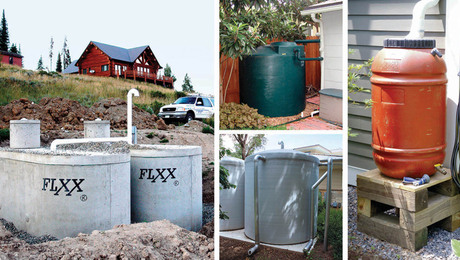*
Has anyone used Thoroseal as a waterproof finish on an interior or exterior block basement wall? It is commonly sold in 50lb bags usually white or gray. Another thing that they recommend is using their additive Acryl 60 at a rate of about 12 quarts per bag at about $10.00 a qt. This seems crazy. Anyone have any thoughts on its effectiveness? They also recommend two coats.
Thanks,
Tony


















Replies
*
Tony:
I have used Thoroseal to paint the walls of my house and my parents house. Neither house had a real water problem to begin with. The walls were "cinder" block and built in the early and mid 50's. My parents house was done in the late 60's and still looks good. My house was done in the late 70's and has a few spots where something is growing under the thoroseal and forming lumps. This house has also had a gutter problem that resulted in water flowing in about 15 years ago. We used water to mix the powder in both cases. In my house, I have also painted with latex over portions of the thoroseal.
I like it, but it is no cure-all for water pouring in. Just good damp-proofing.
Frank DuVal
*I have used it to attempt to control moisture and wet areas, and for that it is useless. I am at a loss for what use it might have, other than to possibly control condensation or dampness in basement areas, and for that it is not too good. A $50 dihumidifier would do a better job.Nice article this month on waterproofing basements.
*Frank,Did you use one or two coats? Am I understanding you right that you put the thoroseal on the walls of the two houses how many years ago?Scooter,You may be right about that dehumidifier. My basement is a half about 16' x 22' with a crawl space through an opening. Floors are damp where there is cracks. It was built as an addition in the late 40's or 50's. What size dehumidifier should I get. Also everything metal down there starts rusting after one winter season.Tony
*I used it on the outside of my basement walls during construction. The walls have remained dry, but I took various other waterproofing measures, so I can't say how effective the Thoroseal was. I used two coats on the exterior. The second coat goes on with much less effort than the first coat. I wouldn't try to use it on the interior side of basement walls.I found I had much better success applying it when I power mixed it. Any cheap "paint mixer" paddle on a decent electric drill is adequate.I used the Acryl 60. Its purpose is to improve adhesion to the wall, so on new bare block walls it probably isn't necessary. Last summer I believe it was about $17/gallon here. The white version of the Thoroseal is quite a bit more expensive than the gray stuff.Last summer when I tried to buy some, I found that a local mining company had purchased the entire stock of Thoroseal from the three local masonry suppliers for use in waterproofing holding tanks. The product has been around for a long time. I'm pretty sure we used that to waterproof the inside of a cement block septic tank on my parents' farm about 35 years ago.
*used it on a couple of block projects.. i like it.. and i think it is effective.. i would use the acyrl additive if it was available..i've also used the UGL product.......an additional benefit to the white is the added brightness and cleanliness in the basement..
*Tony:My parent's house was done when I was a teenager, so probably 35 years ago. The basement was not a leaker, but we used white to brighten the basement walls ( cinder block ). Mom had planned to paint them another color later, but she never repainted so they are still white.My house I bought in 1978 and I sealed the walls right away before I filled it with junque, I mean my valuable hobbies. The house was not a big leaker, but it was damp. Even after the Thoroseal treatment, I have been running a dehumidifier (since 1978 same Emerson) with the output draining into a floor drain. I think it is a typical 25 pint per day unit. When the downspout drain clogged, the gutter overflowed and water did come in at the block to slab seam. I "think" I used two coats. No admix, just water in both cases. I was never told of the admix back then. In half of the basement I have painted over the Thoroseal with latex paint.In a friend's townhouse I used some UGL ( not the water base) coating where the water line from the street came through a block wall. This wall also had water coming down a hill to this middle unit, so there was no where for the water to go except around several town house units. It worked really well in this application, only an occasional drip for 10 years.Frank DuVal
*Ted,Did you also use any type of rubber based material on your exterior walls over the thoroseal? I was under the impression that being that the thoroseal is cement based product, it provides no elasticity for cracks and movement. (I'm assuming that we are talking about below grade application.) Why wouldn't you use it on an interior wall?Mike,Did you use the UGL paintable or powder based?Frank,Pondering this situation myself, if you plug a water feed or a sewer line coming through the wall from the inside, won't the water fill the hole to the depth of the plug and just try to come in somehow? Whereas if the wall is plugged from the exterior side, no penetration unless pipe movement breaks the seal around the plug. I have a similiar situation at my place (my wall is 12" thick with a hole for a 3/4" water main and 6" clay tile in which a 4" pvc line runs through it.Tony
*Yes Tony, water will always try to find a way into a house. So the best course of action is to waterproof the outside wall of basements. But, that involves digging, so most homeowners do the inside plugging first and hope that it works. In my friend's case, it did. Maybe the block was filled with concrete and not hollow? If the blocks were hollow it does seem that the water would have filled the wall below the pipe and the hydrostatic pressure would have forced the water through the next weak link.Frank
*All below grade waterproofing should always be done from the exterior. Thoro fills the voids with smaller aggregate and blocks passage of water but is more acurately a moisture stop or moisture resistant, not waterproof 100%, especially iof below grade. I would use it on a block wall and then coat with ashphaltic or ruberized foundation coating for the waterproofing below grade.For above grade block walls two coats of thoro is suficient to repel wind driven rain which will otherwise penetrate the wall causing efflorescense ande frost damage. Thoro also sells a liquid coating for application on top of the mix. Whether it is a silicone or a concrete sealer type of product I'm not sure. I'm sure their web site (do a search) has more info. The acryl60 is worth using. Not only does it increase adhesion to the wall when used as a primer, adding it to the mix acts as a conditioner to extend the cure time for a stronger surface and resisting frost in cold weather and flaking from overly fast cures in hot weather. A similar product added to grout for tile work will make it more water resistant so I assume that this will do the same.
*Frank,So how would you plug this 2" gap around the sewer line sleeved through the 6" clay pipe (BTW my below grade wall is a poured wall 12" thick) I like to fill it with something I could shoot in there like foam sealant to pack the cavity and then plug it with water plug or something? What do you think?Piffin,Do you know the required amount of Acryl 60 to use per 50lb bag of thoroseal? Also is there any difference between "Super Thoroseal" and "Thoroseal" if you know.Tony
*tony,From the inside out I have: 12" block walls parged with mortar, then the Thoroseal w/Acryl 60 (two coats), then a product called AmerDrain, then 8 to 12 inches of crushed 1.5" limestone, and then Typar fabric. The AmerDrain is a stiff dimpled plastic with a layer of felt-like fabric on it. The idea is that water penetrating the fabric can run down around the dimples to the footer drains. I first read about it in FHB magazine. It ain't cheap. I like the product, but I found it hard to handle and install. If I were to do it again, I'd probably use a "rubber" membrane instead. Frankly, I think the thick layer of crushed limestone is probably my best protection. Underground water just doesn't run horizontally if it can run vertically instead. There is a Thoroseal product for use on both the exterior and interior of foundation walls. It's called "Thoroseal". Just that. The stuff in the bags is "Thoroseal Foundation Coating". That stuff is designed only for exterior use ("Waterproof, cement-based coating for exterior below grade concrete and masonry"). If you download this PDF file (you'll need the free Acrobat Reader software) you can read all about Thoroseal. You may very well already have Acrobat on your computer. Thoroseal PDF fileYou'll need a minimum of 1.5 quarts of Acryl-60 per 50 lb. bag of Thoroseal. You mix the Acryl-60 with an additional three parts water, so 1.5 quarts of Acryl-60 gives you 6 quarts of liquid to mix with the 50 lb. bag. You can double the concentration of Acryl-60 if you want to splurge...I haven't heard of "Super Thoroseal".Go here to browse the Thoroseal products (in English).
*Ted,Thanks for the info. From your post your saying a minimum of 1.5 qts of Acryl60 should be enough for a 50lb bag (mixed with 3pts water). I think I was looking at it as straight Acryl by the quart not with the water diluted giving more volume.Is the AmerDrain applied to your exterior walls? How did you apply it.Tony
*Tony,I'll let someone else answer the correct way to plug the area inside the sleeve around the pipe. You may want to make a new post with this as the heading to get more new people to look.Frank DuVal
*I would go no less than 50/50 Acryl/water for the liquid portion of my mix. You can go 100% Acryl but that's getting extreme and expensive.
*
Has anyone used Thoroseal as a waterproof finish on an interior or exterior block basement wall? It is commonly sold in 50lb bags usually white or gray. Another thing that they recommend is using their additive Acryl 60 at a rate of about 12 quarts per bag at about $10.00 a qt. This seems crazy. Anyone have any thoughts on its effectiveness? They also recommend two coats.
Thanks,
Tony